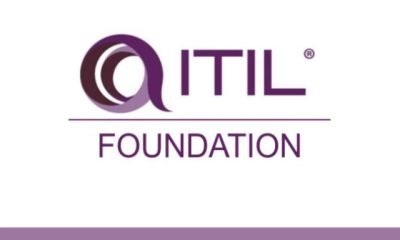Growth
Top 10 Proofreading Tips to Improve Your Resume


When applying for a job, the simplest typo or mistake on your resume can make you seem unprofessional and careless and undermine your chances of success. Having written your resume, it’s essential that you thoroughly proofread it to catch any errors and mistakes. From printing it out, to reading your resume aloud, to using a writing service to help, here are ten top tips to help you improve your resume and make a great first impression.
1. Use Spell Check
Many spelling mistakes and errors can be avoided by ensuring that you’ve enabled the spellcheck feature on your word processor. Once you have finished writing your resume, the first thing you should do is to run a spell-check. This will help you quickly identify and correct any obvious spelling and grammar mistakes.
However, you must ensure that the language is set correctly. Be aware of your audience and ensure that you change the language preference to either British English if you’re applying for a job in the UK, or American English, if your job application is being sent to the US. Similarly, ensure that you use and apply the correct spelling and grammar conventions, depending on which country you’re sending your resume to. Some terminology may be slightly different, so it’s worth checking that you have used it correctly.
Although the spell check feature will help you correct obvious mistakes, it can miss some errors. For instance, it will probably miss an unintentional stray letter or an omitted letter, so that you may be applying for a role as a ‘manger’ instead of as a ‘manager’. Therefore, once you’ve used the spell checker tool, it’s essential that you still personally re-read it and check it carefully.
2. Wait a Day before Proofreading Your Resume
Make sure that you factor in sometime between writing your resume and beginning to proofread it. Ideally, you should wait a day or two before you start to proofread and edit your resume. This break will enable you to get some distance from the document and allow you to return to it with fresh eyes. As such, you’ll be more likely to spot any mistakes you may have made. Equally, proofreading a resume requires time and attention, so make sure that you schedule in your proofreading session for a time when you are alert.
3. Print out a Copy
Printing out your resume on to paper is a helpful proofreading strategy. When we read text on a screen, there is a tendency to skim read, as opposed to reading with care. By contrast, when words are printed on paper, we are more likely to read these with more attention, meaning that it will be easier and more likely for you to be able to successfully identify any errors in your resume.
Once you have written your resume and completed an initial review of it, print it out onto paper. In some cases, it can also help print it out using a different font from the one you are accustomed to reading and writing in. This subtle change can be enough to help your brain pay more careful attention to detail, as opposed to ‘auto-correcting’ mistakes when you see them. It can be a good idea to create a second copy of your resume on which you change the font for this purpose. That way, you won’t forget to change the font back once your proofreading is complete or have to make changes to your original format.
When you are proofreading the paper copy, use a highlighter and a different colored pen to make notes or changes. A red pen works particularly well as it will stand out, ensuring that you’re less likely to miss out on an important edit or note when you begin editing your resume on the screen again.
4. Use a Proofreading Tool or Writing Service
If you have difficulty proofreading your resume or if English isn’t your first language, it can be useful to instead use an online proofreading tool or writing service to help you. There are many services and tools available online which can help check your resume for spelling and grammatical errors. Once you’ve written your resume, you can submit it for proofreading and objective feedback. Some online tools and services will also provide you with tips and suggestions on how to improve the content of your resume, as well as checking for mistakes.
5. Read It Out Loud
One of the most effective proofreading techniques is to read your work aloud. Although this may feel a little awkward and strange to begin it, reading your writing aloud will enable you to focus on what you’ve actually written and identify any mistakes and awkward phrases. Make a note of any phrases you stumble over as you’re reading and ensure that you correct them during your editing.
6. Read It from the Bottom, a Line at a Time
Another useful strategy is to re-read your resume, starting from the bottom of your document. Essentially, you are reading it backwards, one line at a time. This is a slightly time-consuming task, but it’s a great technique for helping you identify stray spelling mistakes which you or the spell check may have missed before. Reading your resume in this way will force you to slow down your reading and allow you to focus more carefully on individual words, as well as smaller details, such as punctuation, capitalization errors and spaces.
7. Re-Read It with a Different Focus Each Time
Reading your resume once is not enough. You are likely to miss some small details on a first or even second reading, so ensure that you schedule in enough time to do multiple readings. It can be useful to focus on different aspects each time you read through your resume. For example, you might want to read it once for spelling, another time focusing on grammar, a third time focusing on verb tenses and a fourth time checking the formatting.
When you check your resume for spelling, it’s especially important to check each individual word, looking out for homophones and contractions. Equally important is to ensure that you are using appropriate and consistent tenses throughout. When referring to your previous jobs, make sure that you write in the past tense, but anything related to your current job and duties should be written in the present tense.
Check thoroughly that all proper nouns have been capitalized and that you have used consistent date formats throughout your resume. Punctuation can be easily overlooked, so ensure that you check that there is only a single space between a period and the beginning of a new sentence. Check too that all sentences have a period at the end and try to avoid using exclamation marks.
8. Check Smaller Details
As you read through your resume, make a note of any recurring mistakes that you find. When you edit your resume, you can use the “Find” function on your computer to ensure that all those mistakes are corrected. Equally important is to check smaller words. Little words, such as ‘of’ and ‘if’ can sometimes get interchanged. It’s essential that you go back through your resume and double-check for these easily missed errors.
9. Ask a Friend to Check It for You
Having worked on your resume for a while and re-read it through several times, it can become challenging to catch any mistakes. In particular, the more familiar that you become with the document, the more likely your brain will start to ‘auto-correct’ any typos or missing punctuation you may have missed.
Asking a trusted friend or family member to read it over for you can be very helpful. Not only will they be able to spot any mistakes you may have missed, but they’ll also be able to provide you with useful and constructive feedback on how to improve the content and layout of your document.
10. Check the Formatting and Design
The design and formatting of your resume are extremely important. An overcrowded and messy resume will be hard to read. Instead, make sure that you allow for plenty of white space. Use headings to break up your resume into different sections, which are easily identifiable. It’s important that your name, address, phone number and email are easy to find and access. As such, ensure that these contact details appear towards the top of your resume.
Most importantly, your resume needs to be easy to read, so ensure that you use a conservative font that is legible. Preferably choose a font such as Times New Roman or Verdana and ensure that it is an appropriate size, ideally size 12.
Conclusion
When you’re applying for a job, your resume is your first chance to impress your potential employer. Give yourself the best possible chance of success by carefully and thoroughly proofreading it, to ensure it’s the best document it can be.


Growth
How Can You Become Wiser by Understanding the Wisdom in Contradiction?


Meditation is beneficial for both the body and the mind. Many studies have established its role in bringing about various health benefits, including improved memory, mental quickness, boosting the immune system, and reducing cellular inflammation.
Besides its mental and physical benefits, meditating also helps in the process of becoming wiser by empowering you to identify wisdom in contradictions. Life is full of them, and what you generally perceive as the truth may be false.
The best way to gain deeper insights into this topic is by taking online meditation classes consisting of step-by-step instructions from an experienced meditation coach who will help you grasp the contradictions of life and how to overcome them.
But what are some things you can expect to learn from lessons on this topic? Read on to find out.
What Are Contra-Wisdoms?
For example, up might sometimes be down, light could be dark, and good may be harmful in disguise. However, when you understand and embrace these differences, you achieve connection rather than perfection.
Sounds confusing? The way out is to learn the art of seeking connection over perfection since the latter always brings disconnection, leading to a state of mental and physical unrest within yourself.
What Lessons Does a Session Consist Of?
You can learn to seek wisdom in contradiction through eight lessons, each focusing on a different aspect of it.
The lessons are:
- Preparing your consciousness.
- Seeking connection.
- Giving what you receive.
- Perceiving your brain.
- Relationship between suffering and freedom.
- Doing nothing.
- Losing your values.
- Being a lifelong student.
Here is a look at some to give you some idea about what you might expect.
Preparing your consciousness
It focuses on helping you tune in to the state of being and consciousness rather than the things you want to do. It is essential to focus on the consciousness rather than the content.
Your physical presence has the most impact rather than anything else. It’s also about creating an inner shift in which you feel good about yourself rather than wait for someone else to do that for you.
Sitting comfortably, closing your eyes, you would focus on a particular situation. But rather than focusing on what you would do, the emphasis would be on being present in that situation and what experience you would like to have.
Seeking connection through perfection
Through the process of connection emerges perfection. When the focus is solely on excellence, it leads to disconnection. Connecting is about seeing the inherent beauty in things and how it comes from them.
Wanting to be perfect comes from thinking, while connection emerges from a deep sense of oneness and wishing well. When every aspect of your life is influenced by connection, and you connect to a larger purpose, almost every obstacle is surmountable.
A small concentration exercise helps you shift your mindset from trying to perfect things to achieving oneness with them. You put yourself in a space and time (at the home, office, etc.) where you seek the best outcome by tuning in with the people and genuinely trying to establish a relationship with them.
Giving what you receive
It is a good idea to give whatever you seek to receive because that is the best way of receiving it. Loving-kindness, compassion, appreciative joy, and a balanced mind are within you.
What you seek to get from others is already present within yourself. Before you seek anything in the world, you should seek it on the inside. Sitting in a comfortable meditative posture, you focus on giving, sharing, appreciating, and experiencing all that is good and beautiful.
The path to becoming wiser lies in understanding the contradictions of things called contra-wisdoms and developing a oneness with them. However, you can do that after receiving the proper guidance from a qualified spiritual coach.
Growth
7 Reasons Why People Hire Personal Development Coaches and Their Skills


Self-development includes all endeavors that enhance a person’s relationships, well-being, and sense of self-worth. A personal development coach can help people improve their performance and reach their best by utilizing motivating principles and techniques. All essential facets of your life, from your beliefs and connections to your work and skill set, can be covered by a life coach.
Why People Are Hiring Personal Development Coaches
1. To Get Ideal Work-life Balance:
Personal growth coaches can assist clients with career planning, job transitions, and enhancing their professional presentation. They can also help people improve their position by imparting productivity and work management abilities.
2. To Enhance Communication Abilities:
Currently, many individuals often desire to get better at communicating with coworkers, family members, or other leaders in their companies. A self-improvement coach can instruct clients on effective body language, listening techniques, and the best way to put their thoughts into words.
3. To Boost Interpersonal Connections:
A personal development coach can counsel engaging with colleagues, friends, family, and strangers with greater consideration and presence. Clients who have improved interpersonal abilities tend to feel that they become a part of the community and interact more.
4. For Better Health:
Consultants for individual development can support people to abide by an active lifestyle. For example, individuals can seek assistance to have a regular schedule to exercise, get more sleep, and eat well.
5. To Enhance Creativity:
The personal improvement coaches can motivate people to improve their creative skills, or they can assist seasoned artists and creativity experts in coming up with new ideas for their projects.
6. To Improve Parenting:
A few coaches concentrate on assisting parents in raising their kids. They will go through parenting theories, methods of correction, and how parents should delegate tasks to one another.
7. To Identify a Career Purpose:
A few individuals may feel that their current profession does not clearly define their purpose. The self-development coaches assist clients in identifying endeavors or alternative career resources that they would find more exciting and meaningful.
What Are the Vital Skills of Personal Development Trainers?
Leadership Capability
The personal development trainers serve as leaders for several people. Leaders motivate followers to modify their behavior and take on difficulties using their ethical virtue, motivational talents, and effective listening abilities. They set a good example for others by offering the clients their complete attention regularly.
Additionally, they employ effective teaching techniques to present fresh viewpoints and ideas.
Business Aptitudes
Entrepreneurship abilities enable you to maintain organization and deliver a top-notch product necessary to convert a concept into a successful firm.
The coach will build business goals with comprehensive planning, organize funds using appropriate accounting procedures, and offer excellent customer service through effective interpersonal relationships. The instructors also use demonstration and public speaking to greet potential clients and make interesting pitches.
Creativity Abilities
For creating clients’ unique action plans, creative abilities are crucial. Every client faces difficulties that must be resolved creatively using abilities including understanding, problem-solving, and cooperation. The imagination of the self-development trainers may be particularly beneficial to clients who want to accomplish artistic objectives.
Effective Networking Abilities
Being well-known in a neighborhood is quite advantageous for personal development instructors. They maintain contact with existing connections and new acquaintances with professionalism by using networking talents.
Relationship development, considerate communication techniques, and the ability to provide value before requesting financial commitments come under networking abilities.
Bottom Line
A personal development instructor will comprehend the client’s present situation, current self-improvement status, and desired future goals. The trainer will provide them with tactics to follow and hold them accountable after helping them focus on the particular area they wish to improve.
Growth
The Importance of Body Language: How to Understand and Use It


We’ve all heard the saying “actions speak louder than words.” Well, that is especially true when it comes to body language. Body language can communicate a lot about a person – their feelings, their intentions, and more. What is there to talk about when the best cunnilingus techniques are based precisely on body language.
To effectively communicate with others, you need to be able to understand their body language. In this blog post, we will discuss the basics of body language and how you can use it to your advantage!
General Information
Body language is a form of nonverbal communication, consisting of body posture, gestures, facial expressions, and eye movements. Humans send and interpret such signals almost entirely unconsciously. Body language exists in both animals and humans, but this article focuses on interpretations of human body language. It is also known as kinesics.
Most of the emotions we feel are universal, being expressed in the same way across cultures. However, some cultural differences do exist in how emotions are expressed. For example, in Western cultures, direct eye contact is considered a sign of respect and sincerity, while in some Asian cultures it may be considered rude or intimidating. Similarly, while a smile is typically seen as a sign of happiness in Western cultures, in some African cultures it may be interpreted as a sign of mockery or aggression.
Body language is an important aspect of communication, often conveying far more meaning than words alone. It can be used to communicate feelings of happiness, sadness, anger, fear, or interest, among many others. It can also be used to convey messages about status, dominance, or aggression. In some cases, body language may provide information that contradicts what is being communicated verbally (e.g., when someone’s verbal message says one thing but their body language says something else).
Body Language for a Good First Impression
Making a good first impression is important in both personal and professional contexts. Though body language is only one part of the equation, it can be key in making a positive impression.
Here are a few tips:
- Stand up straight: Good posture conveys confidence and shows that you’re engaged and interested.
- Make eye contact: Looking someone in the eye communicates trustworthiness and sincerity.
- Offer a firm handshake: A limp or too-strong handshake can come across as either disinterested or overbearing. Instead, aim for a balanced firmness.
- Smile: A genuine smile communicates happiness and approachability. It’s one of the easiest ways to make someone feel welcome.
Above all, remember that body language is only one piece of the puzzle. Making a good first impression also requires being polite, engaging in conversation, and being yourself. With a little practice, you’ll be impressing everyone you meet in no time!
Body Language for Effective Public Speaking
When you’re giving a presentation, the way you carry yourself can be just as important as the words you’re saying. Your body language can convey confidence, engagement, and authority – or it can make you look nervous, disconnected, and even untrustworthy.
If you want to make sure your nonverbal communication is working for you, there are a few things to keep in mind:
- Remember to make eye contact with your audience. This will help them feel like you’re speaking to them directly, and it will also make you appear more confident and sincere.
- Try to use expansive gestures. This will make you appear more open and approachable.
- Avoid fidgeting or crossing your arms, which can make you look closed off or uncomfortable.
By being aware of these simple tips, you can ensure that your body language is conveying the message you want it to.
Conclusion
Body language is an important tool for understanding and interacting with other people. It can be used to improve communication, build rapport, and enhance relationships. It can also be used to detect deception, as people’s nonverbal cues often betray their true feelings or intentions.



 Health11 months ago
Health11 months ago6 Best Ways to Get Quality Sleep



 Social Media11 months ago
Social Media11 months agoLinda Yaccarino: Twitter’s New CEO from NBCUniversal



 Work11 months ago
Work11 months agoFive Things Employees Look for in a Job Role



 shopping12 months ago
shopping12 months agoEssential Tips for Buying Jewelry Online



 Finance12 months ago
Finance12 months agoHow Can You Find Affordable Auto Insurance Using iSelect?



 Tech12 months ago
Tech12 months agoWhat Are the Advantages of ITIL Foundation Certification for Organizations?



 Education9 months ago
Education9 months ago7 Tips for Writing Short Stories That Captivate and Resonate



 Entertainment11 months ago
Entertainment11 months ago5 Famous Gamblers and Their Most Memorable Quotes




















